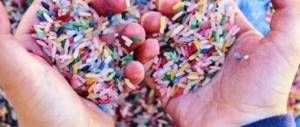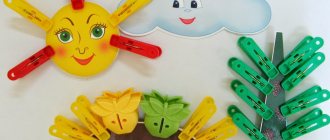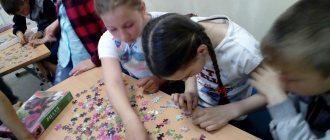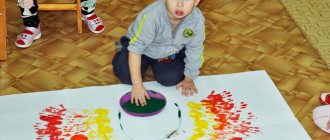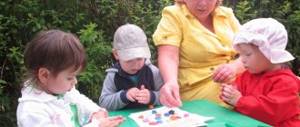Definition
Coordinated movement of the hands and small finger muscles is how fine motor skills are defined. Exercises aimed at its development teach children at the age of 2 to concentrate and think logically. Stimulation of the finger muscles is directly related to the development of speech, vision and memory, and the functioning of the nervous system and brain is activated. It’s not for nothing that they say that the brain is at your fingertips.
Developing fine motor skills
Through play, the baby learns about the world around him. In kindergarten, already in the younger group, it is necessary to conduct educational games for children 2 years old. During the games, coordinated hand movements develop, and you need to start with passive gymnastics - massage.
Massage
The massage is combined with finger role-playing games, and the baby’s hands are warmed up to the fairy tale “Magpie-Magpie.” They massage not only the palms, but also the forearm.
If a child rolls a small pencil on the table with the fingers of both hands, this is an additional massage of the palms.
Finger games
They stretch and train their fingers to the tune of an interesting story; the exercises are carried out in the following format:
- static – keep your fingers in a certain position for some time;
- dynamic – develop the mobility of the fingers, move them in different directions;
- relaxing - shaking, light stroking.
To develop grasping movements, there are special toys that create tactile sensations:
- rattles, tumblers;
- rubber dolls, sorters.
Fine motor skills in children 2-3 years old develop well if they play with the following objects:
- button, clothespins;
- sorting through chestnuts, cones, nuts.
Important! All activities must be supervised by adults.
Finger paint
By drawing, the baby trains the small muscles of the hand; he is taught to hold the thumb and index finger correctly. The younger group of children begins to draw gradually:
- traces flat figures - a palm, a toy;
- draws using anchor points;
- completes the second half of the image.
Coloring a picture with colored pencils is a great way to develop imagination.
Application
In the younger group, it is dangerous to give scissors to a child, so let him tear pictures from magazines with his hands and make a collage out of them, as best he can. We need to help him glue them together into a pattern on a blank sheet of paper.
Modeling
A 2-year-old child will be fascinated by modeling from clay, plasticine or dough. He can create figures and paste them over:
- flower pot;
- bottle;
- twigs.
It will be interesting for the child to sculpt flowers, money and see what they themselves have made.
Card file of exercises and games with goals according to the Federal State Educational Standard
The card file of exercises according to federal standards includes the following types of classes:
- to relax your arms (hands);
- for the development of motor skills using an unsharpened hex pencil;
- for the development of motor skills using natural materials (cones);
- for the development of motor skills with the help of a prickly massage ball.
The first type includes the following exercises:
- "Fish" in the water;
- “Helicopter”, which involves winding thread around an elastic band or ball;
- “Hedgehog” with palms;
- “Hare and Fox” with quickly and slowly “walking” fingers;
- “A conversation between two”, involving interaction between several group members;
- “Flight of the Birds” with active hand work;
- “Track” with buttons sewn to the fabric;
- “Pebbles” with plasticine laid out in a straight line;
- “Watch” aimed at active movements of the hands;
- “Lock”, which includes movements of the fingers and hands;
- “Spider” - moving fingers along the wall;
- “Scissors” with cutting movements of the fingers;
- “Firefighter”, which involves running your fingers along a “ladder”;
- “Peck fingers” - connecting the thumb with the rest in turn.
The second type includes the following exercises:
- “Pencil rolling” using the palm of your hand;
- “Making fire” with rolling a pencil up and down between your hands;
- "Slide" with rolling a pencil up and down one hand using the other hand;
- “Spinner” with a pencil spinning on the table;
- “Helicopter” with a pencil spinning in the air;
- “Crane” with lifting an object with two fingers;
- “Excavator” with lifting a pencil with your finger;
- “Swing” with swinging a pencil with two connected fingers.
The third type includes the following exercises:
- “Twist the bump” using your palms;
- “Roll the bump” using your palms on the table;
- “Catch the cone” by throwing it from hand to hand.
The fourth type includes the following exercises:
- rolling an object back and forth on the table;
- rolling an object around the table in a circle;
- finger pressure;
- catching a thrown ball;
- pressing on the ball with both hands;
- moving the ball from hand to hand with acceleration.
Painting class in the “Golden Khokhloma” style in senior groups of preschool educational institutions
Finger games and exercises
Finger exercises and games include many variations that require small and large objects of different types and densities. Paper, cereals, bulk and small items are suitable for this.
Important! It is best to accompany lessons with sayings in poetic form. Thanks to this, children will develop their speech apparatus and memory.
Many of the exercises will be useful to the baby in the future (for example, the ability to tie shoelaces, fasten buttons).
Finger drawings
Finger drawings as an element of classes are recommended to be done before lunch. During this period, children are especially active. At first, it is worth conducting a lesson for a couple of minutes, gradually increasing the time to 20 minutes without breaks.
For classes you need to purchase special paints, sold in any store. They have a special consistency that does not require adding water. The lid should fit tightly to the jar.
The sheets you choose should be A3 format so that the child can safely draw and the colors are bright. The presence of “CE” on the box means that the product meets world-class standards.
Massage of palms and fingers
Massage is a key point in the development of children's motor skills. The massage includes stroking the arms from fingers to palms, including the hands. Classes are accompanied by tongue twisters and poems.
Finger massage
Note! Before the massage, you need to warm up the baby's hands. The duration of the procedure should not be more than 5 minutes. Massage should be done for 10 days once a month.
Junior group. Early childhood, nursery. Children 1-4 years old
"Smart Fingers" club for children 3–4 years old. Part 2 February 1 week 1. Games with a massage ball. We squeeze the balls tightly. p. 17 We squeeze the balls tightly, we strain our muscles, So that our fingers are never afraid of work. (children alternately tightly squeeze the ball in one and the other palm)
2. Games with a handkerchief. Ball. page 26 (Children put a handkerchief...
"Smart Fingers" club for children 3–4 years old. Part 1, week 1 1. Games with a massage ball. Warm-up. No. 1 p. 10 Handles, hands, wake up. (children roll the ball in their hands, making movements back and forth, left and right between their palms) Fingers, fingers, sprinkler. (roll the ball on each finger of the right and left hand)
Head, head, wake up...
Development of fine motor skills in older preschoolers
- January 22, 2011
Competition “My Pedagogical Initiative” – Stage 2
“The origins of children’s abilities and talents are at their fingertips. From the fingers, figuratively speaking, come the finest threads-streams that feed the source of creative thought. In other words, the more skill in a child’s hand, the smarter the child.”
V.A. Sukhomlinsky
Relevance. As a teacher of a senior preschool age group, I see the relevance of this problem at the present stage in preparing preschoolers for writing. At school, at the first stage of learning, children often experience difficulties with writing: their hands quickly get tired, the working line is lost, and letters cannot be written correctly. These difficulties are caused by underdeveloped fine motor skills of the fingers and insufficient development of visual-motor coordination.
Goal: I set myself a goal: to select the most effective methods and means for the development of fine motor skills. In the process of developing fine motor skills, the following tasks : visual-motor coordination, orientation in microspace are improved, and the fine muscles of the fingers are strengthened.
Having studied the experience of working on this problem, I came to the conclusion that work on the development of fine motor skills should be based on an integrated approach - a combination of speech development, physical education, finger exercises and play exercises.
It has been proven that the level of speech development depends on the degree of development of fine motor skills. They mutually influence each other. Manipulative activities stimulate speech development, and the use of speech material develops articulatory motor skills. Coordination of movements contributes to the development of flexibility, precision of movements, and the development of the eye. All this increases the performance of the cerebral cortex, activates mental activity and puzzles using counting sticks. Since the main activity of preschoolers is play, the tasks are of a playful nature.
Result of the work:
The result of my work was thematic game complexes (10-15 minutes), which are held with children in the evening and consist of the following activities:
1. Massage of the hands using tongue twisters.
2. Finger gymnastics with elements of logorhythmics.
3. Working with various materials (seeds, counting sticks, paper, test plastic, laces, etc.)
4. Games for coordination of movements (with rubber and rag balls, magnetic fishing rods).
5. Copying patterns, drawings or working in copybooks.
Work principles. The basic principles of work on the development of fine motor skills correspond to the basic pedagogical principles: the developmental nature of training, systematicity and consistency, consciousness and activity in learning, clarity and taking into account age and individual characteristics. Game complexes are carried out with a subgroup of children (no more than 10 people) and require a wide variety of handouts in sufficient quantities. Our parents help us prepare it.
The variety of materials used allows children to vary their activities from folding origami to dough plastic, from lacing to beading. To select speech material, it is good to use riddles, tongue twisters, physical education minutes, and short poems.
In the presentation I presented, you will see the most striking moments in working on the development of fine motor skills.
1. Working with threads is very diverse. We start by drawing pictures based on the silhouette.
2. Another way to create paintings from threads is to cut them finely and glue them to a stencil. Children enjoy working in pairs.
3. Lacing is a familiar matter from the younger group. We suggest using a lacing method to depict printed numbers on a wooden board with holes.
4. Weaving with multi-colored laces helps the child develop a sense of rhythm and coordinate the work of both hands.
5. With the help of seeds and fruits, patterns and landscapes are created, creative imagination develops.
6. Counting sticks are the first assistants in any lesson. From them we lay out letters, answers to riddles, and solve puzzles.
7. Pebbles help us not only develop coordination of movements and the eye, but also consolidate visual images of letters and numbers.
8. Pasta and cereals are not only tasty, but also beautiful.
9. What fashionista would refuse jewelry created by children's hands.
Results. Systematic work in this direction makes it possible to achieve the following positive results: the hand acquires good mobility and flexibility, stiffness of movements disappears, pressure changes, which in the future helps children easily master the skill of writing. To diagnose the development of writing skills, you can use workbooks and copybooks. In the future, we will organize a “Naughty Fingers” circle.
An example of a game complex for the development of fine motor skills for senior preschool age on the theme “Duck”
Tasks
Educational: teach to “read” a step-by-step diagram of paper folding, consolidate knowledge about selecting food for birds, improve children’s speech (rhythm and clarity of pronunciation).
Educational: fostering a caring attitude towards birds.
Developmental: develop fine motor skills, eye control and coordination of movements.
PROGRESS of the lesson
1. Finger massage “Birds”
(For the first two lines, children clench and unclench their fingers. Then they massage each finger on both hands in turn. For the last line, children hide their hands behind their backs)
Sing along, sing along: Ten birds are a flock. This bird is a nightingale, This bird is a sparrow, This bird is an owl, A sleepy little head. This bird is a waxwing, This bird is a corncrake, This bird is a starling, A gray feather. This is a finch, This is a swift. This is a cheerful siskin. Well, this one is an evil eagle. Birds, birds, go home.
2. Finger gymnastics “Five ducklings ”.
(One of the hands - “mother duck” - stands on the table, leaning on the elbow. The fingers are folded together. The second hand is the ducklings. We perform wave-like movements towards the “duck”. The number of extended fingers corresponds to the number of ducklings. To the words “Their mother is on the shore waits for a “nod” with the hand (“mother duck”).
Five ducklings are swimming forward, Their mother is waiting on the shore, But only four ducklings returned to their mother. (fingers gradually curl) Four ducklings are swimming forward... Three ducklings are swimming... Two ducklings are swimming... Here is one swimming forward, His mother is waiting on the shore, And again the five ducklings returned to their mother back.
3. Working with various materials. Origami "Duck".
4. Game for coordination of movements with magnetic fishing rods “Feed the duck”.
On the floor there are pictures depicting animal food (cereals, grain, grass, meat, milk, etc.). Iron brackets are attached to the edges of the pictures, and children have fishing rods with magnets in their hands. The children's task is to catch the desired picture and move it to the table with their duck. The teacher helps to remove the picture from the fishing rod if it is chosen correctly. Repeat the game 2-3 times.
5. Working with squared notebooks. "Grass for ducklings."
Used Books:
– T.A. Tachenko. Fine motor skills. Gymnastics for fingers. – E.Yu.Timofeeva, E.N.Chernova. Finger steps. Exercises to develop fine motor skills. – E.S. Bolshakova. Formation of fine motor skills of hands. – M.N. Bronzova. Copybooks. Learn, baby! – S.E. Gavrina, N.L. Kutyavina. Tests (series “The entire preschool program”) - Periodicals “Hoop”, “Preschool Education”, “Child in Kindergarten”.
Author: Lazareva Irina Mikhailovna – teacher of the 1st qualification category of the MDOU general developmental kindergarten No. 25 “Zabava” of the Bugulminsky municipal district of the Republic of Tatarstan, work experience in the specialty - 15 years.
I aspired to become a teacher since childhood, graduated from a pedagogical institute and came to work in a kindergarten, which became a second home for me. Very inquisitive, sociable, I like to work in a team. I always try to share my experience with colleagues. Every year I take part in city pedagogical readings and methodological associations. I constantly strive to learn new things, evaluate them objectively, and apply them in my work. I consider the most important thing in the work of a teacher to be daily, painstaking work with children. I work in a senior preschool group and take an active part in the work of creative groups in kindergarten. (Lapis lazuli)
